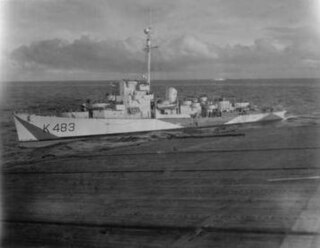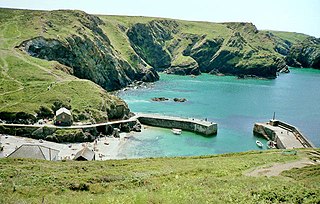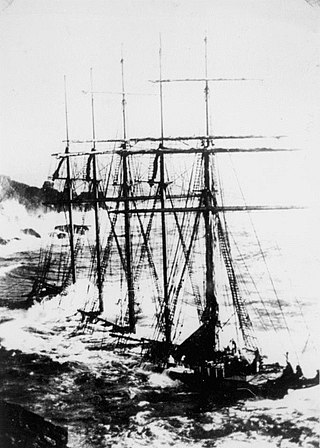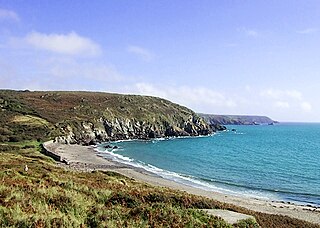Related Research Articles


Helston is a town and civil parish in Cornwall, England, United Kingdom. It is situated at the northern end of the Lizard Peninsula approximately 12 miles (19 km) east of Penzance and 9 miles (14 km) south-west of Falmouth. Helston is the most southerly town on the island of Great Britain and is around 1.5 miles (2.4 km) farther south than Penzance. The population in 2011 was 11,700.

Porthleven is a town, civil parish and fishing port near Helston, Cornwall, England, United Kingdom. The most southerly port in Great Britain, it was a harbour of refuge when this part of the Cornish coastline was infamous for wrecks in the days of sail. The South West Coast Path from Somerset to Dorset passes through the town. The population at the 2011 census was 3,059.
A lizard is a reptile.

HMS Kempthorne (K483) was a Captain-class frigate of the Royal Navy and named after Captain John Kempthorne of HMS Mary Rose in 1669.

The Battle of Havana was a naval engagement that took place between the British Caribbean squadron and a Spanish squadron based near Havana during the War of Jenkins' Ear. The battle occurred on the morning of the 12th and ended on 14 October 1748. The belligerents consisted of two squadrons under the command of Admiral Don Andres Reggio of the Spanish Navy and Admiral Sir Charles Knowles of the Royal Navy, respectively. The British succeeded in driving the Spanish back to their harbour after capturing the Conquistador and ran the vice-admiral's ship Africa on shore, where she was blown up by her own crew after being totally dismasted and made helpless. Although the advantage had clearly been with Knowles, he failed to use this to deliver a decisive blow. The battle was the last major action in the War of Jenkins' Ear which had merged with the larger War of the Austrian Succession.

Cadgwith is a village and fishing port in Cornwall, England, United Kingdom. It is on the Lizard Peninsula between The Lizard and Coverack. It is in the civil parish of Grade Ruan.

Mullion is a civil parish and village on the Lizard Peninsula in south Cornwall, England, United Kingdom. The nearest town is Helston approximately 5 miles (8 km) to the north.

Mullion Cove, or Porth Mellin, is a small community on the West Coast of the Lizard Peninsula in Cornwall, England, and on the eastern side of Mount's Bay. The Cove forms part of the parish of Mullion, and is accessible by road from Mullion village, 1 mile (1.6 km) to the northeast, and also via the South West coast path. It lies within an Area of Outstanding Natural Beauty.

HMS Anson was a ship of the Royal Navy, launched at Plymouth on 4 September 1781. Originally a 64-gun third rate ship of the line, she fought at the Battle of the Saintes.

The geography of Cornwall describes the extreme southwestern peninsula of England west of the River Tamar. The population of Cornwall is greater in the less extensive west of the county than the east due to Bodmin Moor's location; however the larger part of the population live in rural areas. It is the only county in England bordered by only one other county, Devon, and is the 9th largest county by area, encompassing 3,563 km² (1,376 mi²). The length of the coast is large in proportion to the area of the county. Cornwall is exposed to the full force of the prevailing south-westerly winds that blow in from the Atlantic Ocean. To the north is the Celtic Sea, and to the south the English Channel.

HMS Exmouth was a 91-gun screw propelled Albion-class second-rate ship of the line of the Royal Navy.

HMS Primrose was a Royal Navy Cruizer-class brig-sloop built by Thomas Nickells, at Fowey and launched in 1807.

The Sea Dogs were a group of English privateers and explorers authorised by Queen Elizabeth I to raid England's enemies, whether they were formally at war with them or not. Active from 1560 until Elizabeth's death in 1603, the Sea Dogs primarily attacked Spanish targets both on land and at sea, particularly during the Anglo-Spanish War. Members of the Sea Dogs, including Sir John Hawkins and Sir Francis Drake, also engaged in illicit slave trading with Spanish colonies in the Americas.

The Lizard Lifeboat Station can refer to several Royal National Lifeboat Institution lifeboat stations located on the Lizard in Cornwall, United Kingdom. The first was established at the southernmost point of the peninsula in 1859. Since then successive stations have all been in operation at different locations on The Lizard. The current station is located at Kilcobben Cove 0.5 mi (0.80 km) east of the village of Lizard.

Adolf Vinnen was a five-masted barquentine that was built by Friedrich Krupp Germaniawerft, Kiel, Germany. She was wrecked on her maiden voyage in 1923.

HMS Lizard was a 28-gun Coventry-class sixth-rate frigate of the Royal Navy, in service from 1757 to 1828. Named after the Lizard, a peninsula in southern Cornwall, she was a broad-beamed and sturdy vessel designed for lengthy periods at sea. Her crewing complement was 200 and, when fully equipped, she was armed with 24 nine-pounder cannons, supported by four three-pounders and twelve 1⁄2-pounder swivel guns. Despite her sturdy build, she was plagued with maintenance problems and had to be repeatedly removed from service for repair.
HMS Royal Anne Galley was a 42-gun fifth-rate frigate of the Royal Navy. She ran aground and was wrecked during a gale off Lizard Point, Cornwall, while she was travelling to the West Indies. The wreck is a Protected Wreck managed by Historic England.

Kennack Sands is a beach and sand-dune system on the east coast of the Lizard Peninsula, Cornwall, England, UK.
References
- Croix, P.D. (2003). Patrick O'Brian's Navy. London: Salamander Books.